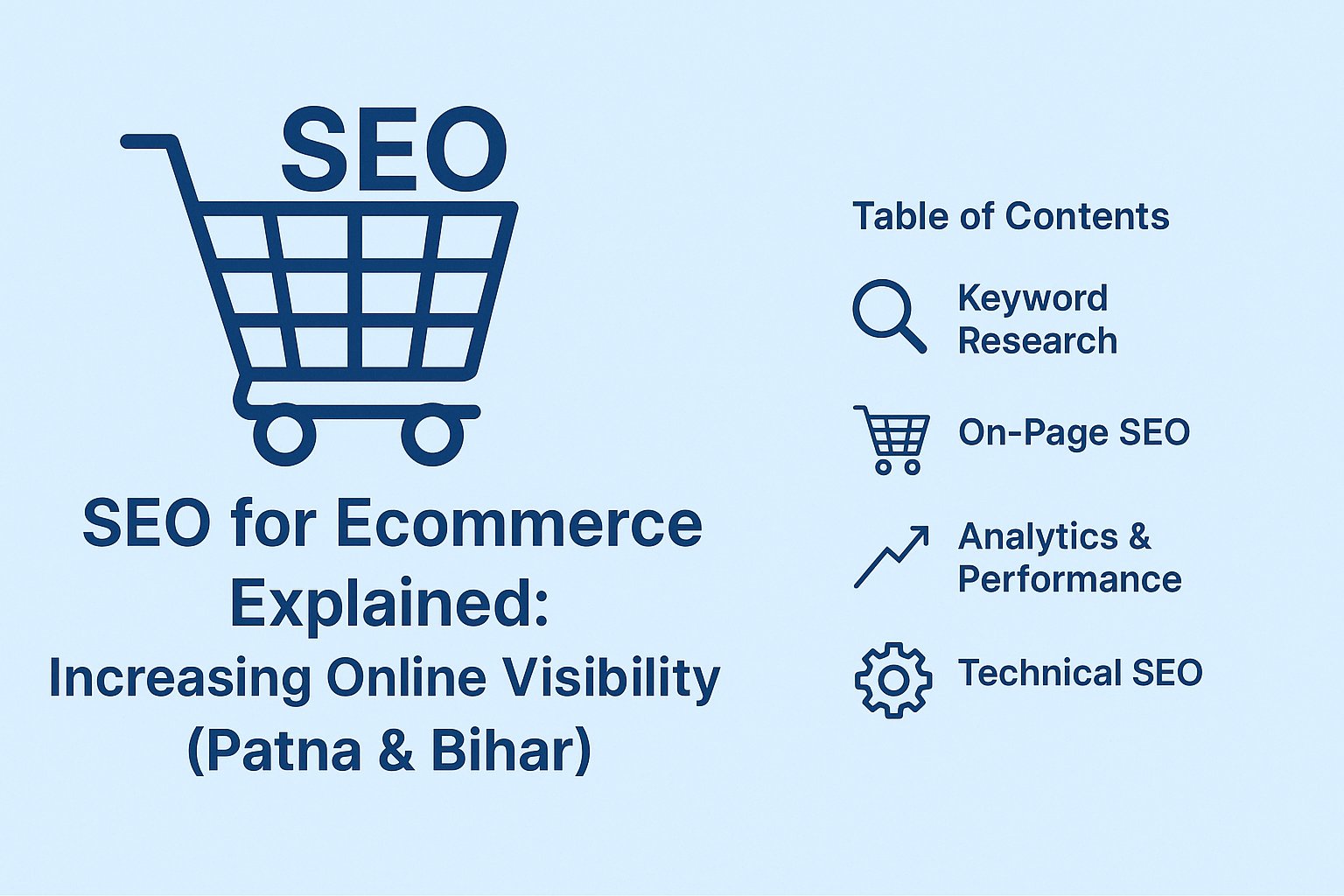In the crowded ecommerce landscape, visibility is everything. If your store doesn’t appear when customers in Patna or across Bihar search for your products, you’re losing sales. This guide explains Ecommerce SEO—from keyword research to technical fixes—so your online store ranks higher, attracts qualified traffic, and converts more visitors.
What is Ecommerce SEO?
Ecommerce SEO is the process of optimising an online store to rank higher on search engines. It spans keyword strategy, product & category page optimisation, site architecture, speed, and content. The goal is simple: win intent-driven traffic that converts.
- Increase visibility for commercial product queries
- Drive qualified, purchase-ready traffic
- Boost conversions and revenue without relying only on ads
Why It Matters for Your Store
Most shopping journeys start with search, and the majority of users don’t look beyond page one. Ranking higher builds trust and captures more clicks—especially for local intent like “buy shoes in Patna” or “laptop store Bihar online”.
Foundations of Ecommerce SEO
- Solid keyword research mapped to user intent
- Optimised product pages (titles, descriptions, structured data)
- High-quality category & faceted navigation strategy
- Fast, mobile-first, and technically clean website
- Helpful content + authoritative backlinks
Keyword Research for Ecommerce
Target buyer-intent and long-tail phrases that indicate readiness to purchase (e.g., “buy eco-friendly yoga mat”, “best DSLR under 50k in Patna”). Combine product terms with modifiers like brand, price, size, colour, and location.
- Build keyword clusters for each category and prioritise by demand and competitiveness.
- Map every target keyword to a single page to avoid cannibalisation.
- Localise where relevant: “online grocery delivery in Patna”, “furniture store Bihar”.
On-Page SEO for Product Pages
Product pages are your revenue pages. Make them discoverable and convincing:
- Titles & H1s: Include primary keyword + modifiers (brand, model, colour, location if relevant).
- Descriptions: Benefit-led, unique content—avoid manufacturer copy. Answer specs, use-cases, and FAQs.
- Media: Compressed images, descriptive
alttext, and demo videos where possible. - Structured Data: Add Product + Review + Offer schema to enable rich results (price, ratings, availability).
- UX: Clear CTAs, trust badges, delivery/returns, and fast checkout.
Category Page Optimisation
Category pages often capture broader search demand and can outrank products:
- Unique intro copy explaining the range, use-cases, and key differentiators.
- Logical filters (price, size, brand) with crawl control to prevent duplicate/faceted index bloat.
- Internal links to best-sellers and top sub-categories to distribute authority.
- Optimised meta title/description and header hierarchy (H1→H2→H3).
Advanced Strategies
- Faceted Navigation: Decide which combinations are indexable; manage the rest with
noindex, canonical, or parameter rules. - Internal Linking: Contextual links from blogs and guides to key categories and products.
- Search Intent Refresh: Re-optimise pages as SERP features and intent evolve.
Technical SEO for Ecommerce
- Speed: Aim for sub-2s LCP; compress images, lazy load, preconnect critical resources.
- Mobile-First: Responsive UI/UX with tap-friendly controls and stable layout.
- Index Hygiene: Fix duplicate content with canonicals, manage pagination, and avoid thin/empty pages.
- Security: HTTPS, secure checkout, and trust seals.
- XML Sitemaps & Robots: Keep fresh and aligned with index strategy.
Content Marketing for Ecommerce
Use content to capture non-brand demand and support rankings:
- Buying guides (e.g., “How to Choose the Right Running Shoes for Patna’s Winters”)
- Comparison posts and FAQs targeting informational queries that lead to products
- Seasonal/local content for Bihar festivals, weather, and trends
Building Backlinks (Safely)
- Pitch niche bloggers, review sites, and local publishers.
- Partner for giveaways, influencer lists, and gift guides.
- Avoid paid link schemes—focus on relevance and authority.
Analytics & Continuous Optimisation
Track what matters and iterate. Use Search Console and Analytics to monitor:
- Organic sessions & revenue attribution
- Click-through rate (meta tests), bounce rate, and conversions
- Keyword movement by category and SKU
Test titles/meta, improve content depth, and fix tech issues on a monthly cadence. Small, consistent improvements compound.
Common Ecommerce SEO Mistakes to Avoid
- Duplicate manufacturer descriptions across products
- Thin category pages with no unique copy
- Uncontrolled faceted URLs bloating index
- Ignoring mobile performance and Core Web Vitals
- Relying only on paid ads without an organic moat
The Future of Ecommerce SEO
- AI & Personalisation: Smarter on-site search and recommendations.
- Voice Search: Conversational, question-led content and structured data.
- Video: Optimised product explainers and UGC with schema and captions.
Key Takeaways
- Target buyer intent with clean page mapping
- Make product & category pages fast, rich, and unique
- Control crawl/indexing of variants and facets
- Publish helpful content and earn relevant links
- Measure, learn, and improve continuously
FAQs
How is Ecommerce SEO different from traditional SEO?
It focuses on product/category pages, faceted navigation, structured data, and conversion UX—areas unique to online stores.
How long until results?
Typically 3–6 months for meaningful movement, depending on competition, site health, and content velocity.
What matters most?
Accurate keyword mapping, unique content, technical cleanliness, and authority (links + brand).
Should ecommerce brands blog?
Yes—guides, comparisons, and FAQs capture informational demand and funnel traffic to category/product pages.
Work With NetrX Digital (Patna)
Ready to scale your store with a sustainable organic engine? NetrX Digital’s Ecommerce SEO services help Patna & Bihar brands rank, get consistent traffic, and grow sales. Prefer a quick chat? Contact us or explore our work.
Written by NetrX Digital

